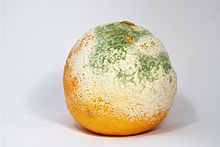Our website is made possible by displaying online advertisements to our visitors.
Please consider supporting us by disabling your ad blocker.
Mold


A mold (US, PH) or mould (UK, CW) is one of the structures that certain fungi can form. The dust-like, colored appearance of molds is due to the formation of spores containing fungal secondary metabolites. The spores are the dispersal units of the fungi.[1][2] Not all fungi form molds. Some fungi form mushrooms; others grow as single cells and are called microfungi (for example yeasts).
A large and taxonomically diverse number of fungal species form molds. The growth of hyphae results in discoloration and a fuzzy appearance, especially on food.[3] The network of these tubular branching hyphae, called a mycelium, is considered a single organism. The hyphae are generally transparent, so the mycelium appears like very fine, fluffy white threads over the surface. Cross-walls (septa) may delimit connected compartments along the hyphae, each containing one or multiple, genetically identical nuclei. The dusty texture of many molds is caused by profuse production of asexual spores (conidia) formed by differentiation at the ends of hyphae. The mode of formation and shape of these spores is traditionally used to classify molds.[4] Many of these spores are colored, making the fungus much more obvious to the human eye at this stage in its life-cycle.
Molds are considered to be microbes and do not form a specific taxonomic or phylogenetic grouping, but can be found in the divisions Zygomycota and Ascomycota. In the past, most molds were classified within the Deuteromycota.[5] Mold had been used as a common name for now non-fungal groups such as water molds or slime molds that were once considered fungi.[6][7][8]
Molds cause biodegradation of natural materials, which can be unwanted when it becomes food spoilage or damage to property. They also play important roles in biotechnology and food science in the production of various pigments, foods, beverages, antibiotics, pharmaceuticals and enzymes.[9] Some diseases of animals and humans can be caused by certain molds: disease may result from allergic sensitivity to mold spores, from growth of pathogenic molds within the body, or from the effects of ingested or inhaled toxic compounds (mycotoxins) produced by molds.[1]
- ^ a b Moore D, Robson GD, Trinci AP, eds. (2011). 21st Century Guidebook to Fungi (1st ed.). Cambridge University Press. ISBN 978-0521186957.
- ^ Madigan M, Martinko J, eds. (2005). Brock Biology of Microorganisms (11th ed.). Prentice Hall. ISBN 978-0-13-144329-7. OCLC 57001814.
- ^ Morgan, Mike. "Moulds". Microscopy UK. Archived from the original on 28 March 2019. Retrieved 26 June 2012.
- ^ Chiba University, Japan. "Fungus and Actinomycetes Gallery". Chiba University Medical Mycology Research Center. Archived from the original on 19 July 2012. Retrieved 26 June 2012.
- ^ Hibbett DS, Binder M, Bischoff JF, Blackwell M, Cannon PF, Eriksson OE, et al. (2007). "A higher level phylogenetic classification of the Fungi" (PDF). Mycological Research. 111 (5): 509–547. CiteSeerX 10.1.1.626.9582. doi:10.1016/j.mycres.2007.03.004. PMID 17572334. S2CID 4686378. Archived from the original (PDF) on 2009-03-26.
- ^ "Slime Molds". herbarium.usu.edu. Utah State University. Archived from the original on 20 February 2020. Retrieved 21 April 2020.
- ^ "Slime Molds: Myxomycetes" (PDF). Cornell University. Retrieved 21 April 2020.
- ^ "Introduction to the Oomycota". ucmp.berkeley.edu. UC Berkeley. Archived from the original on 6 May 2020. Retrieved 21 April 2020.
- ^ Toma, Maria Afroz; Nazir, K. H. M. Nazmul Hussain; Mahmud, Md Muket; Mishra, Pravin; Ali, Md Kowser; Kabir, Ajran; Shahid, Md Ahosanul Haque; Siddique, Mahbubul Pratik; Alim, Md Abdul (2021). "Isolation and Identification of Natural Colorant Producing Soil-Borne Aspergillus niger from Bangladesh and Extraction of the Pigment". Foods. 10 (6): 1280. doi:10.3390/foods10061280. PMC 8227025. PMID 34205202.
Previous Page Next Page


